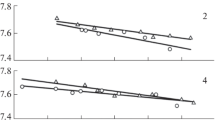Abstract
We used the sessile drop method to study the temperature and concentration dependences of the density and surface tension of melts in the manganese – tin system. The density polytherms are linear dependences which are consistent with those calculated by the additivity rule for the specific volumes of the pure components. The temperature dependences of the surface tension are also linear and their temperature coefficient changes from negative values for tin-rich melts to positive values for melts with high manganese content. The surface tension isotherm is satisfactorily described by the Popel-Pavlov equation. We calculated the composition of the surface layer of the studied melts as a function of the composition of the bulk phase. We have shown that the model for the surface layer of melts in the Mn – Sn system at 1300°C is close to monolayer.
Similar content being viewed by others
REFERENCES
N. L. Pokrovskii and M. Saidov, “Properties of metallic solutions. V. The effect of zinc, aluminum, cadmium, manganese, and bismuth on the properties of liquid and solid tin,” Zhurn. Fiz. Khim., 34, No. 9, 1601–1609 (1955).
V. N. Eremenko and V. I. Nizhenko, “Effect of carbon on the surface tension of liquid cobalt and nickel and their interfacial tension with aluminum oxide,” Ukr. Khim. Zhurn., 26, No. 4, 423–428 (1960).
V. I. Nizhenko and Yu. I. Smirnov, “Apparatus for determining the surface properties and density of melts with semiautomatic feed of samples to the heating zone,” in: Investigation Methods and Properties of the Interface between Contacting Phases [in Russian], Nauk. Dumka, Kiev (1977), pp. 33–40.
Yu. V. Naidich and V. N. Eremenko, “«Large drop» method for determining surface tension and density of molten metals at high temperatures,” Fizika Metallov i Metallovedenie, 11, No. 6, 883–888 (1961).
Yu. M. Ivashchenko and V. N. Eremenko, Principles of Precision Measurement of the Surface Energy by the Sessile Drop Method, [in Ukrainian], Nauk. Dumka, Kiev (1972).
D. V. Khantadze, “Calculation of the volume of a sessile drop,” Fizika Metallov i Metallovedenie, 15, No. 3, 470–472 (1963).
B. V. Nekrasov, Principles of General Chemistry [in Russian], Khimiya, Moscow (1965), Vol. I.
V. I. Nizhenko, “Density of liquid metals and its temperature dependence,” in: Investigation Methods and Properties of the Interface between Contacting Phases [in Russian], Nauk. Dumka, Kiev (1977), pp. 125–163.
M. Hansen and K. P. Anderko, Structures of Binary Alloys [Russian translation], Metallurgizdat, Moscow (1962), Vol. II, pp. 613–1448.
B. C. Allen, “The surface tension of liquid chromium and manganese,” Trans. Met. Soc. AIME, 230, No. 6, 1357–1361 (1964).
N. K. Dzhemilev, S. I. Popel, and B. V. Tsarevskii, “Surface tension isotherms for iron-manganese-silicon melts,” in Surface Phenomena in Melts and Solid Phases Originating from Them [in Russian], Kabardino-Balkarskoe. Kn. Izdat., Nal'chik (1965), pp. 306–311.
V. A. Rudenko and N. V. Tolstoguzov, “Surface properties of Fe-Mn-C alloys and their adhesion to graphite and high-manganese slag,” Izv. Vuzov. Chernaya Metallurgiya, No. 12, 64–68 (1968).
P. V. Geld, B. A. Baum, and M. S. Petrushevskii, Melts in Ferroalloy Production [in Russian], Metallurgiya, Moscow (1973).
S. I. Popel and V. V. Pavlov, “Thermodynamic calculation of the surface tension of solutions,” in: Surface Phenomena in Melts and Solid Phases Originating from Them [in Russian], Kabardino-Balkarskoe Kn. Izdat., Nal'chik (1965), pp. 46–60.
P. J. Spencer and J. N. Pratt, “Thermodynamic study of liquid manganese-tin alloys,” Trans. Met. Soc. AIME, 242, No. 8, 1709–1711 (1968).
V. N. Eremenko, G. M. Lukashenko, and V. L. Pritula, “Thermodynamic properties of manganese-tin liquid alloys,” Ukr. Khim. Zhurn., 39, No. 10, 1005–1008 (1973).
A. I. Rusanov, Phase Equilibria and Surface Phenomena [in Russian], Khimiya, Leningrad (1967).
M. A. Reshetnikov, “Equation for the surface tension isotherm for irrational (nonsingular) binary systems,” in: The Physical Chemistry of Surface Phenomena at High Temperatures [in Russian], Nauk. Dumka, Kiev (1971), pp. 3–11.
R. Kh. Dadashev, “Composition and thickness of the surface layer for multicomponent solutions,” Rasplavy, No. 6, 20–25 (1992).
R. A. Kutuev, Thermodynamic Parameters of the Surface Layer for Binary and Multicomponent Melts of Low-Melting p Metals, PhD Thesis [in Russian], Grozny (2001).
V. I. Nizhenko, “Estimation of the composition of the surface layer of binary metallic melts,” Poroshk. Metall., Nos. 5–6, 60–69 (2000).
Author information
Authors and Affiliations
Rights and permissions
About this article
Cite this article
Nizhenko, V.I. Surface Properties of Manganese – Tin Liquid Alloys. Powder Metallurgy and Metal Ceramics 42, 517–522 (2003). https://doi.org/10.1023/B:PMMC.0000013225.95000.c6
Issue Date:
DOI: https://doi.org/10.1023/B:PMMC.0000013225.95000.c6



